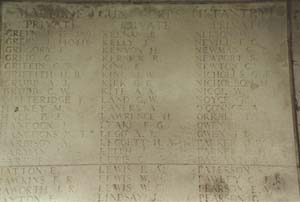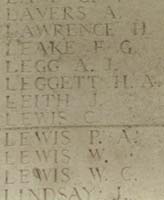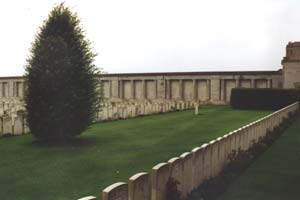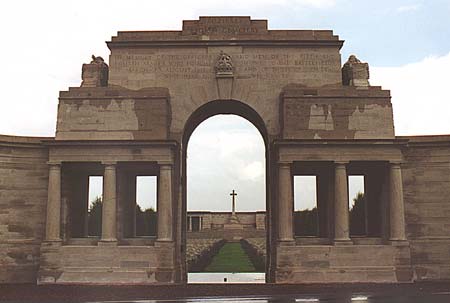Photographed
August 2000
The Machine Gun Corps
The Machine Gun Corps was a war-time creation in the First World
War, originally centralising machine gun crews from a number of
infantry and cavalry regiments and other technically competent soldiers.
The Corps was intended to exploit the Vickers Medium Machine Gun
in support of other arms operations. The Machine Gun Corps was formed
in 1915 with three branches: the Cavalry Branch, the Infantry Branch,
and the Motor Branch or Motorised Machine Gun Service. The Cavalry
and Infantry Branches wore the corps cap badge of crossed Vickers
machine guns beneath a crown. The Motor Branch of the Machine Gun
Corps (the MMG Service) wore the corps cap badge with the letters
MMG beneath.
The Heavy Branch of the Machine Gun Corps grew out of the MMG
Service in 1916 and then gave birth to the Tank Corps (later The
Royal Tank Corps and then The Royal Tank Regiment) in 1917. The
Motor Branch of the Machine Gun Corps gradually disbanded, and its
personnel were absorbed into the Tank Corps.
Brigade Machine Gun Companies were formed in most divisions
in Jan 1916, and in Feb 1918 the machine gun companies (about 300)
were grouped into battalions (about 100). The Cavalry Branch had
26 squadrons. The Motor MG Service had about 40 companies. They
were numbered in several separate sequences, such as "Mobile
MG Company", "Light Armoured Car Battery", "Railway
Armoured Motor Battery", and "Light Car Patrol".
Some units were mounted on motorcycles with sidecars.
Existing separately outside the MG Corps was the "Guards
Machine Gun Regiment" of 1918-20, also known as the "6th
or Machine Gun Regiment of Foot Guards", consisting of five
battalions - the three Household Cavalry regiments having been totally
converted to this role, the five Foot Guards regiments contributing
a regular and a reserve battalion.
Belton Park, near Grantham in Lincolnshire, was also the Corps
Depot and Training establishment of the Machine Gun Corps from 1915
to 1920. It is now in the care of the National Trust for England
and Wales.
The Machine Gun Corps was formally disbanded in 1922.



